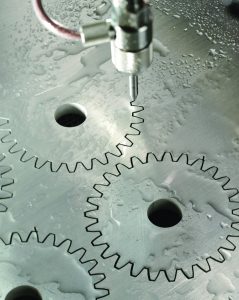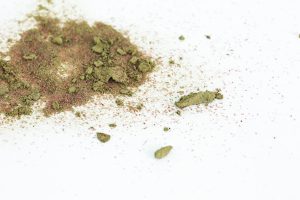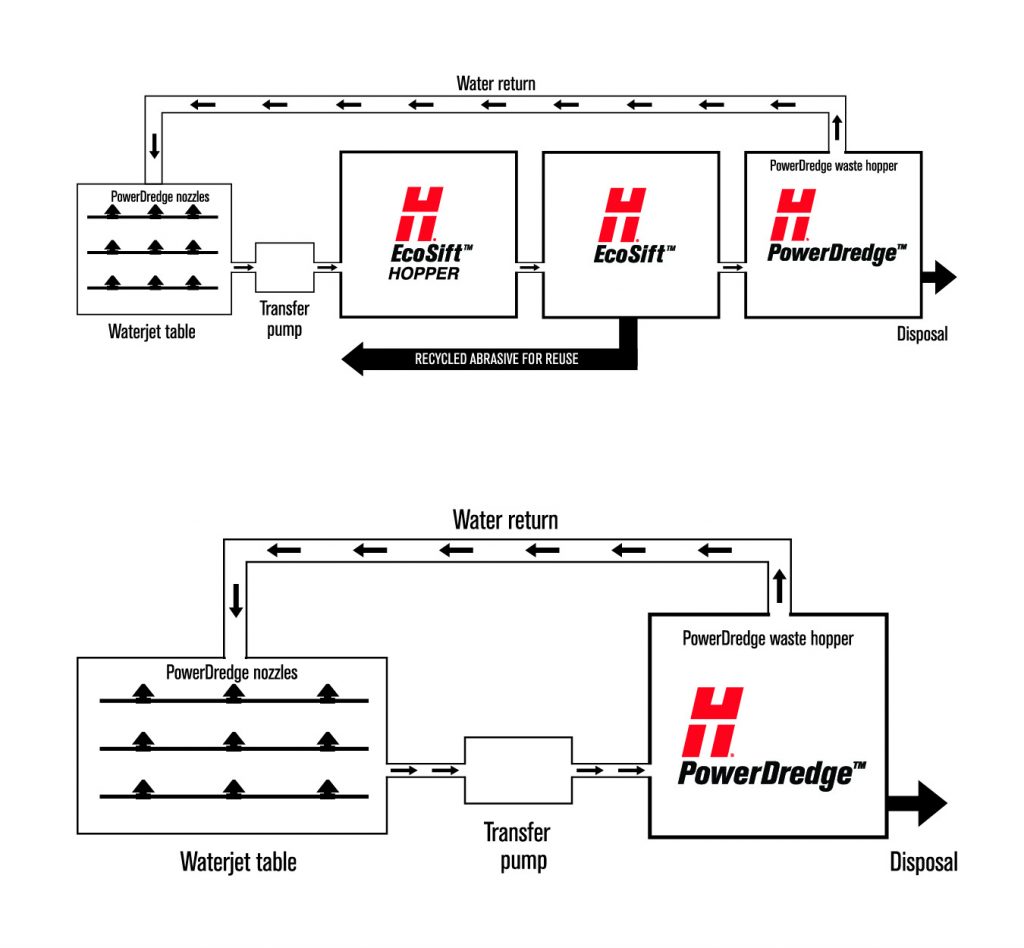As owners of waterjet cutting systems know, waterjet is an excellent cutting process for a wide variety of industrial applications. It can cut nearly any material no matter the thickness and provides excellent cut quality without impacting the structural integrity of the material being cut.
Unfortunately, owners of abrasive systems are faced with another reality: higher operating costs when compared to some other cutting methods. Abrasive cost is responsible for more than half of a waterjet’s operating cost. A typical installation will spend more money on abrasive than labor to actually run the table.
This 55 percent estimate assumes proper use of reliable calculators to determine proper cut speed, the optimum starting level for a given orifice/nozzle combination and pressure to ensure abrasive is not overfed. Businesses not using these tools can easily experience even higher abrasive costs.
Good as New
While preventive maintenance and aftermarket service have long been Though traditionally high, the advent of new technology is making it possible for waterjet system owners to reduce their operating cost through improved management of their abrasive. Instead of discarding abrasive after just one pass through the cutting head, a lot of this abrasive is reusable. Testing and microscopic analysis confirms up to 60 percent of this abrasive matches the specifications of brand new abrasive. How does a majority of this used abrasive remain as good as new? When cutting at 60,000 pounds per square inch or below only a portion of the abrasive is pulverized. The majority manages to reach the bottom of the tank without any significant change to its shape, size, or overall characteristic. This abrasive can be reused without impacting cut quality.
 The key then is managing this abrasive. Companies cutting with waterjet need a reliable method of separating out this “good” abrasive from the pulverized, used up abrasive sitting at the bottom of the cutting table. Two separate steps are actually needed. Step one involves first collecting and removing the abrasive from the bottom of the table. Current options are either messy, labor intensive, expensive, or a combination of the three. The most rudimentary method is to simply empty the water table once the amount of abrasive collected at the bottom interferes with normal operations and, using a shovel, remove the abrasive at the bottom.
The key then is managing this abrasive. Companies cutting with waterjet need a reliable method of separating out this “good” abrasive from the pulverized, used up abrasive sitting at the bottom of the cutting table. Two separate steps are actually needed. Step one involves first collecting and removing the abrasive from the bottom of the table. Current options are either messy, labor intensive, expensive, or a combination of the three. The most rudimentary method is to simply empty the water table once the amount of abrasive collected at the bottom interferes with normal operations and, using a shovel, remove the abrasive at the bottom.
Though this method may prove adequate for companies with smaller tables who cut a relatively small amount of material, it is still time intensive and difficult work as the wet abrasive at the bottom of the table is dirty and heavy. Larger companies can make this process less difficult by using a backhoe instead of a shovel, however, this method is still time intensive and difficult since it also involves lost production time caused by the need to remove the cutting slats, drain the table, bring in the backhoe, and then adequately scoop out the sludge at the bottom.
A third method is the hiring of a specialized pump truck to suck out the abrasive. This method is quicker than the previously mentioned methods leading to less downtime and lower labor costs, but those savings are quickly negated by the cost involved in hiring a pumping company. Specialized abrasive removal products are also available although these products require a high capital investment or have limited effectiveness.
Eliminating Tank Clean Outs
What is needed is an abrasive removal product capable of eliminating time and labor-intensive tank clean outs. This is especially critical in the price-driven and competitive fabrication market, where increased profits are often derived by reducing manufacturing costs rather than increasing prices. Job shops, and fabricators especially, know the best way to increase profitability is by making their overall process more lean. The product would therefore need to:
- Reduce waterjet system down time by increasing the speed of abrasive removal
- Minimize the need for difficult, manual labor
- Simplify abrasive transport from waterjet table to waste area
Simple integration, without a need for additional water, electricity, high-pressure supply lines, or man hours to operate is another desired feature because of the number of tables in current operation, as is reliability. In short the product would need to be simple yet automated. A new system from Hypertherm, called the PowerDredge™, meets the above requirements. The system works as follows:
- A series of up to nine pump-powered nozzles are placed at the bottom of the waterjet table
- The pump vacuums in used abrasive
- Used abrasive moves through galvanized plumbing and is pre-filtered by a strainer to remove large particles. It then travels to the PowerDredge waste hopper, where it collects in a large, easy to remove bulk bag
- Most of the water vacuumed into the PowerDredge waste hopper siphons through the bulk bag and flows back to the waterjet table via a gravity feed
- If the intake nozzles become clogged, a compressed air system back flushes the system to remove the debris and return the system to its normal intake capacity
 As there are a wide variety of waterjet tables in use today, any abrasive removal system would ideally have different configurations to match differing business needs. For example, the system could come with fixed or flexible tubing, standard or heavy duty strainers, etc.
As there are a wide variety of waterjet tables in use today, any abrasive removal system would ideally have different configurations to match differing business needs. For example, the system could come with fixed or flexible tubing, standard or heavy duty strainers, etc.
Disposal of Waste
Regardless of the method chosen to remove the abrasive, the next step is the same: disposal. The waterjet owner needs to pay someone to transport this heavy abrasive and then dispose of it. The cost for this step varies depending on distance to the disposal site and the regulatory environment. Though garnet abrasive is inert and by itself, not hazardous, the nature of the “sludge” in the tank is dependent upon what is being cut. To ensure hazardous material does not inadvertently make its way to a landfill, some local and state governments will require testing before disposal.
Whether additional testing is required or not, the bottom line is transportation and disposal costs money.
Most people can easily accept the need to pay for waste disposal, however, as mentioned earlier, approximately 60 percent of the abrasive isn’t actually waste. In essence, the business owner is paying to transport and dispose of perfectly good abrasive and then paying more to purchase new abrasive to replace the abrasive he or she just disposed of.
A few savvy business owners have managed to reduce their disposal costs by working with other businesses. Instead of going to a landfill, they have found alternative uses for their abrasive. They might sell or give it to a construction company for use as backfill or to a company that can use it as a concrete, asphalt, or paver additive. Still, no matter how generous the arrangement, the money and energy spent to transport the abrasive will never equal the money spent on the purchase of new abrasive. In essence, the business owner is throwing money away.
 Reuse and Recylce
Reuse and Recylce
Companies, especially those doing large amounts of abrasive cutting, will almost certainly experience a cost savings through the adoption of an abrasive recycling program. Once the abrasive is collected, either manually or through the use of an abrasive recovery system like the PowerDredge, it is ready to be sorted and reused. Such an abrasive recycling system could work as follows:
- Used abrasive flows into a hopper where an abrasive slurry is created
- Slurry is vacuumed into a recycling unit and filtered
- Overly small or damaged abrasive falls into a waste bin or abrasive recovery bin
- Reclaimed abrasive is dried
- Dried abrasive is deposited into a bag for reuse
The utilization of a system like this can lead to a significant cost savings for companies since abrasive cost accounts more than half of a waterjet’s operating cost, even surpassing labor, and up to 60 percent of the abrasive that has passed through the waterjet system contains the same characteristics as brand new abrasive. This abrasive can be reused without any discernable difference in cut quality or cut speed.
In addition to lowering the amount of abrasive you need to purchase, and to reducing storage, transport, and disposal costs, an abrasive recycling system can also contribute to a leaner manufacturing environment by reducing the costs associated with placing new orders. This would include time spent placing a new order and shipping and / or delivery fees. In addition, early adoption of an abrasive recycling system could help a company further offset costs by serving as an abrasive collection point. Companies can further reduce their need for “new” abrasive by taking in abrasive from nearby companies. Another option is to offer a fee-based recycling program to other abrasive waterjet users.



















